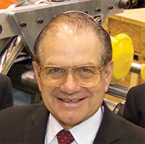Commentary: Ray Orbach
 |
| Photo: Reidar Hahn, Fermilab |
Focus on the future
Over the next few years, the United States and the international high-energy physics communities will see great scientific opportunities and profound changes. These, in turn, will pose profound challenges. We must make the right choices on the right timescales to ensure the vitality and continuity of the field of elementary particle physics for the next several decades and to maximize the potential for major discovery throughout that period.
Three events are notable:
- Within the next several years, the US accelerator-based program will complete two highly successful experimental campaigns—the Tevatron at Fermilab and the B Factory at SLAC. These two accelerators are making very significant advances in the field, and I congratulate the teams at both facilities for their achievements to date and for their success in running these accelerators far above their original design luminosities.
- Second, in the next year the Large Hadron Collider at CERN is scheduled to commence operations, opening wide the door to physics at Terascale energies and ushering in a period of new and exciting scientific opportunity.
- Finally, the Global Design Effort (GDE) recently released a reference design for the International Linear Collider (ILC)—a machine that through its power, precision, and clarity holds great promise for deepening our insight into the mysteries of the universe.
Many individuals and many groups already have given considerable thought and effort to the path forward in high-energy physics. The EPP2010 National Academy Report of April 2006 and the October 2006 Particle Physics Project Prioritization Panel (P5) Roadmap Report articulate a broad set of scientific opportunities and compelling priorities: the highest priority is to go to the Terascale. Given the high stakes—the risks and the rewards of various paths—I welcome the opportunity to work with the high-energy physics community on the future of the field.
The Department of Energy (DOE) is committed to working as an international partner on the R&D for the ILC. Let us make no mistake about the magnitude of such an effort: the path to possible deployment of the ILC will take time. The GDE suggests the R&D alone could take three to five years. In addition, because the ILC will be international, at some point it is necessary to put together a government organization of funding states. This is no small task, as the ITER negotiations demonstrated. It took three years to conclude these negotiations, and that for a facility for which the engineering drawings and cost estimates were firm. Finally, the future of accelerator research and operations at Fermilab needs to extend to the construction phase to keep the United States competitive for the proposed ILC. The DOE position is that we must “keep the door open” by having a competitive high-energy accelerator physics program at Fermilab, capable of being the site for the ILC. All these conditions require a concerted effort to map out detailed projections of international arrangements (R&D), the nature of the international organization of governments, and a vibrant future for Fermilab and the high-energy physics community within the United States.
Within this context, it is important that the High Energy Physics Advisory Panel focus on the future of elementary particle physics. If the ILC were not to turn on until the middle or end of the 2020s, what are the right choices to ensure the vitality and continuity of the field during the next two to three decades and to maximize the potential for major discovery during that period? Given the technological and resource challenges involved, the high-energy physics community must develop a sufficiently compelling scientific rationale, outline a credible path forward, and mobilize a coherent national effort on a scale that would ultimately be necessary for a facility investment of this scope. Since World War II, the United States has had a leadership role in high-energy physics, and we at DOE are committed to maintaining US leadership in this field.
Raymond L. Orbach is Under Secretary for Science at the US Department of Energy.
Click here to download the pdf version of this article.


